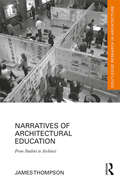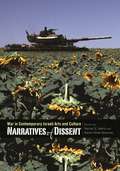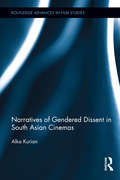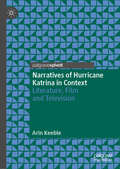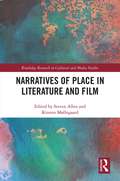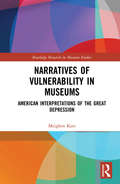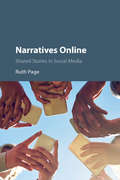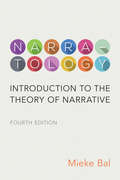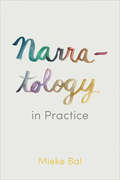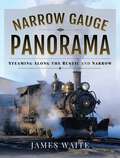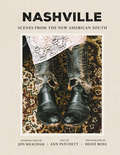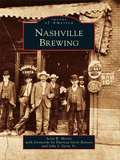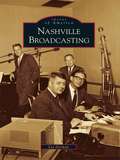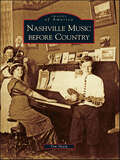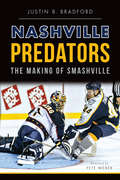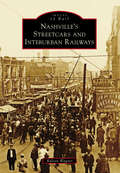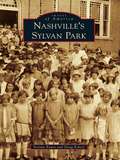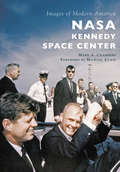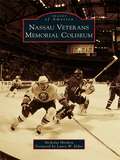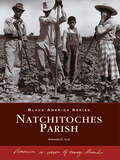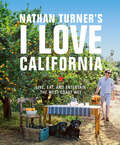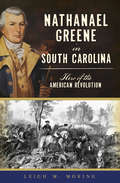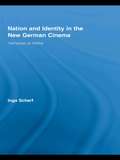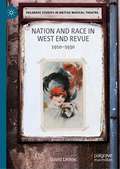- Table View
- List View
Narratives of Architectural Education: From Student to Architect (Routledge Research in Architecture)
by James ThompsonNarratives of Architectural Education provides an overview of life as an architecture student, detailing how a layperson may develop an architectural identity. This book proposes becoming an architect as a personal narrative of professional development structured around various stages and challenges associated with identity transformation. Using a case study of aspiring architects along multiple time points of their professional education, Thompson investigates the occupational identity of architects; how individuals construct a sense of themselves as future architects and position themselves within the architectural community. This book provides previously unexamined insights into not just the academic development of an architect, but also the holistic and experiential aspects of architectural education. It would be ideal for those in the educational field of architecture, to include students, educators, interns, and mentors.
Narratives of Dissent: War in Contemporary Israeli Arts and Culture
by Rachel S. Harris Ranen Omer-ShermanThe year 1978 marked Israel's entry into Lebanon, which led to the long-term military occupation of non-sovereign territory and the long, costly war in Lebanon. In the years that followed, many Israelis found themselves alienated from the idea that their country used force only when there was no alternative, and Israeli society eventually underwent a dramatic change in attitude toward militarization and the infallibility of the IDF (Israel Defense Forces). In Narratives of Dissent: War in Contemporary Israeli Arts and Culture editors Rachel S. Harris and Ranen Omer-Sherman collect nineteen essays that examine the impact of this cultural shift on Israeli visual art, music, literature, poetry, film, theatre, public broadcasting, and commemoration practices after 1978. Divided into three thematic sections-Private and Public Spaces of Commemoration and Mourning, Poetry and Prose, and Cinema and Stage-this collection presents an exciting diversity of experiences, cultural interests, and disciplinary perspectives. From the earliest wartime writings of S. Yizhar to the global phenomenon of films such as Beaufort, Waltz with Bashir, and Lebanon, the Israeli artist's imaginative and critical engagement with war and occupation has been informed by the catalysts of mourning, pain, and loss, often accompanied by a biting sense of irony. This book highlights many of the aesthetic narratives that have wielded the most profound impact on Israeli culture in the present day. These works address both incremental and radical changes in individual and collective consciousness that have spread through Israeli culture in response to the persistent affliction of war. No other such volume exists in Hebrew or English. Students and teachers of Israeli studies will appreciate Narratives of Dissent.
Narratives of Gendered Dissent in South Asian Cinemas (Routledge Advances in Film Studies)
by Alka KurianThis book conducts a post-colonial, gendered investigation of women-centred South Asian films. In these films, the narrative becomes an act of political engagement and a site of feminist struggle: a map that weaves together multiple strands of subjectivity—gender, caste, race, class, religion, and colonialism. The book explores the cinematic construction of an oppositional narrative of feminist dissent with a view to elaborate a historical understanding and theorisation of the ‘materiality and politics’ of the everyday struggle of Indian women. The book analyzes the ways that ‘cultural workers’ have tended to use subversive narratives as a tool of resistance. Narratives that are political, ideological, classed, raced and gendered offer the focus of this exploration. Through strategies of disclosure and documentation of memory, personal experiences, and imaginary events shaped by the larger historical, political, and cultural contexts, these discursive texts engage in the processes of struggle against a plethora of oppression: caste, class, religion, patriarchal, sexual, and (neo)colonial. The study looks at the manner in which, through their creative and aesthetic interventions, South Asian film makers enable the articulation of an alternative gendered subjectivity as well as constitute the ground for personal and collective empowerment. Films discussed include Shyam Benegal’s Nishaant, Nandita Das’ Firaaq, Beate Arnestad’s My Daughter the Terrorist, and Sarah Gavron’s Brick Lane.
Narratives of Hurricane Katrina in Context: Literature, Film and Television
by Arin KeebleThis book analyzes six key narratives of Hurricane Katrina across literature, film and television from the literary fiction of Jesmyn Ward to the cinema of Spike Lee. It argues that these texts engage with the human tragedy and political fallout of the Katrina crisis while simultaneously responding to issues that have characterized the wider, George W. Bush era of American history; notably the aftermath of 9/11 and ensuing War on Terror. In doing so it recognizes important challenges to trauma studies as an interpretive framework, opening up a discussion of the overlaps between traumatic rupture and systemic or, “slow violence.”
Narratives of Place in Literature and Film (Routledge Research in Cultural and Media Studies)
by Steven Allen Kirsten MøllegaardNarratives of place link people and geographic location with a cultural imaginary through literature and visual narration. Contemporary literature and film often frame narratives with specific geographic locations, which saturate the narrative with cultural meanings in relation to natural and man-made landscapes. This interdisciplinary collection seeks to interrogate such connections to probe how place is narrativized in literature and film. Utilizing close readings of specific filmic and literary texts, all chapters serve to tease out cultural and historical meanings in respect of human engagement with landscapes. Always mindful of national, cultural and topographical specificity, the book is structured around five core themes: Contested Histories of Place; Environmental Landscapes; Cityscapes; The Social Construction of Place; and Landscapes of Belonging.
Narratives of Vulnerability in Museums: American Interpretations of the Great Depression (Routledge Research in Museum Studies)
by Meighen KatzNarratives of Vulnerability in Museums is a study of the challenges museums face when they present narratives of instability, uncertainty, and fear in their exhibitions. As a period of sustained societal and personal vulnerability, the Great Depression remains a watershed era in American history. It is an era when iconic visual culture of deprivation mixes in the popular imagination with groundbreaking government policy and has immense potential for museums, but this is accompanied by significant challenges. Analysing a range of case studies, the book explores both the successes and obstacles involved in translating historical narratives of vulnerability to the exhibition floor. Incorporating an innovative, trans-genre museological model, the book draws connections between exhibitions of history, art, and technology, as well as heritage sites, focused on a single era. Employing interpretations of housing, preserved and reconstructed, to discuss ideas of belonging and community, the book also examines the power of the iconic national story and the struggle for local relevance through discussions on strikes and industrial action. Finally, it examines the use of fine art in history exhibitions to access the emotional aspects of historical experience. The result is a volume that considers both how societies talk about less celebratory aspects of history, but also the expectations placed on museums as interpreters of the public narrative and agents of change. Narratives of Vulnerability in Museums makes a significant contribution to discourses of museum and heritage studies, of interwar history, of the social role of cultural institutions, and to vulnerability and resilience studies. As such, it should be essential reading for scholars and students working in these disciplines, as well as architecture, cultural studies, and human geography.
Narratives Online: Shared Stories in Social Media
by Ruth PageStories are shared by millions of people online every day. They post and re-post interactions as they re-tell and respond to large-scale mediated events. These stories are important as they can bring people together, or polarise them in opposing groups. Narratives Online explores this new genre - the shared story - and uses carefully chosen case-studies to illustrate the complex processes of sharing as they are shaped by four international social media contexts: Wikipedia, Facebook, Twitter and YouTube. Building on discourse analytic research, Ruth Page develops a new framework - 'Mediated Narrative Analysis' - to address the large scale, multimodal nature of online narratives, helping researchers interpret the micro- and macro-level politics that are played out in computer-mediated communication.
Narratology: Introduction to the Theory of Narrative, Fourth Edition
by Mieke BalSince its first publication in English in 1985, Mieke Bal's Narratology has become an international classic and the comprehensive introduction to the theory of narrative texts, both literary and non-literary. Providing insights into how readers interpret narrative text, the fourth edition of Narratology is a guide for students and scholars seeking to analyze narratives of any language, period, and region with clear, systematic and reliable concepts. With the addition of in-depth analysis of literary nuances and methods, award-wining cultural theorist Mieke Bal continues to present narrative concepts with clarity. Bal uses a systematic framework to better explain how narratives function, are formed, and eventually interpreted by the reader, while presenting a comprehensive study of the surface perception of language, the perceived narrative world, point of view, and characterization.
Narratology in Practice
by Mieke BalNarratology in Practice opens up the well-known theory of narrative to various disciplines in the humanities and social sciences. Written as a companion to Mieke Bal’s international classic Narratology: Introduction to the Theory of Narrative, in which the examples focus almost exclusively on literary studies, this new book offers more elaborate analyses of visual media, especially visual art and film. Read independently or in parallel with its companion, Narratology in Practice enables readers to use the suggested concepts as tools to assist them in practising narrative analysis.
Narrow Gauge Panorama: Steaming Along the Rustic and Narrow
by James WaiteThis is James Waite’s second book for Pen & Sword about narrow gauge railways. He has travelled extensively in search of interesting, and often obscure, railways in remote locations. His previous book looked at the narrow gauge scene around the world and how many of its historic railways were surviving in the twenty first century. This new volume looks at some of them in greater detail and uses much hitherto unpublished material. The book is full of attractive and rarely seen photos. Some of them depict railways that were in their last days of everyday use, while others show heritage operations which still look much as they did when the trains were running commercially.
Nashville: Scenes from the New American South
by Ann Patchett Heidi Ross Jon MeachamNashville: Scenes from the New American South beautifully captures my home city of Nashville in this exciting moment of change and growth.— AL GOREThis book is excruciatingly gorgeous. Every page makes me homesick. —CONNIE BRITTON A great book about a great city.— JOHN PRINEThis has been a time of such great change for Nashville that I think we are all very curious to see who we are now.— GILLIAN WELCHThis book reminds me, in the sweetest way possible, that I probably should have never left Nashville.— CHRIS THILEIntroduction by Pulitzer Prize-winning Author Jon MeachamA dynamic, experiential, and intimate portrait that explores the many sides of the legendary Southern city and country music capital, from award-winning writers Ann Patchett, Jon Meacham, and acclaimed photographer Heidi Ross.Nashville is a creative collaboration that awakens the senses, providing a virtual immersion in this unique American city hailed as the Athens of the South. Patchett, Ross, and Meacham in his introduction, at once capture both the city’s iconic historical side—its deep, rich Southern roots, from its food and festivals to its famous venues, recording studios, and style—and its edgier, highly vibrant creative side, which has made it a modern cultural mecca increasingly populated by established and upcoming artists in art, film, and music.Nashville celebrates Nashvillians’ beloved locales and events, both established and new, that are the heart of the city’s character including:Bobbie’s Dairy DipBroadwayCumberland RiverBuchanan Arts DistrictBolton’s Chicken and FishDino’sEast Nashville Tomato Arts FestivalGermantownThe GulchGrand Ole OpryPie Town (SoBro)Pride FestivalPrince’s Hot ChickenSchermerhorn Symphony CenterStanley Cup PlayoffsTennessee Performing Arts CenterTennessee State FairThird Man RecordsWXNA Independent RadioHere, too, are engaging vignettes spotlighting the diverse talent that makes the Tennessee city a significant cultural incubator and influencer, including singer-songwriters Marty Stuart, Gillian Welsh, and Dave Rawlings; film director Harmony Korine, textile designer Andra Eggleston, country music fashion designer to the stars Manuel, chef Margot McCormack, acclaimed pastry chef Lisa Donovan, and model and musician Karen Elson.Blending exceptional narrative, evocative photography—including 175 black-and-white and color photographs—and a bold graphic design, Nashville is an intimate, textured panorama that brilliantly illuminates one of America’s most remarkable treasures.
Nashville Brewing (Images of America)
by Scott R. Mertie Patricia Gerst Benson John J. Gerst Sr.Known for country music, antebellum homes, the Parthenon, and Civil War battlefields, Nashville also has a rich brewing history that spans 100 years. Several breweries were established in the late 1800s, but the William Gerst Brewing Company alone endured into the 20th century and even survived Prohibition. Once one of the largest breweries in the South, Gerst brewed its last batch in 1954, leaving Nashvillians unable to enjoy locally brewed beer until the dawn of the recent microbrewery revolution. Nashville Brewing offers readers a pictorial account of the William Gerst Brewing Company-an important but almost forgotten part of Nashville history.
Nashville Broadcasting
by Lee U. DormanBuilt by a 16-year-old high school student named Jack DeWitt, the first radio station in Nashville went on the air in 1922. Three years later, DeWitt helped start WSM, arguably one of the nation's greatest radio stations, and in 1950, he and WSM put Nashville's first television station on the air. Over the years, Nashville has had its share of local radio personalities, such as Noel Ball, Coyote McCloud, and Gerry House, as well as television personalities like Jud Collins, Bill Jay, and Larry Munson. Nationally recognized stars such as Dinah Shore, Oprah Winfrey, Pat Sajak, and Pat Boone started their careers in Nashville as well. Here are the stories and images of the people heard on transistor radios and the programs--including Five O'Clock Hop, Ruffin' Reddy, and The Mickey Mouse Club--watched by children while they did their homework.
Nashville Music before Country (Images of America)
by Tim SharpNashville is a name synonymous with music. Years before the first radio broadcast of country music from Nashville�s Grand Ole Opry, music and publishing were central to Nashville�s self-identity. Thousands of songs flooded into the Cumberland and Tennessee River valleys from Southern Appalachia, sung by folk performers. These songs became the foundation for the folk-hymn traditions that grew throughout Tennessee. Into this stream flowed a body of African American spirituals, gospel, and minstrel songs. The arrival of trained German musicians brought classical styles to this gathering stream of musical confluences. These musicians found a home in the academies and businesses of Nashville. Nashville Music before Country is the story of how music merged with education, publication, entertainment, and distribution to set the stage for a unique musical metropolis. The images for Nashville Music before Country come from private collections as well as public libraries and archives.
Nashville Predators: The Making of Smashville (Sports)
by Pete Weber Justin B. BradfordNashville may be the country music capital, but local hockey fans know it as Smashville. The Predators adopted their name from the bones of a saber-toothed tiger found beneath a local building. Craig Leipold first purchased the expansion rights in 1997, and the team quickly built a loyal following. It won twenty-eight games in the inaugural season. Twelve seasons later, the team finished second in the Central Division and appeared in its first-ever conference semifinals. One year later, it finally dispatched its long-standing rival Detroit Red Wings 4-1 in the opening round of the playoffs. Author Justin Bradford details the fascinating history through unique player anecdotes and perspectives from those involved in the team's rise to prominence.
Nashville's Jewish Community (Images of America)
by Lee DormanNashville's Jewish community traces its beginning to 1795 with the birth of Sarah Myers, the first Jewish child born here. Her parents, Benjamin and Hannah Hays Myers, were both from prominent pre-Revolutionary War families in New England and stayed in Nashville just one year before moving to Virginia. The next few settlers--Simon Pollock, a doctor, in 1843; the Frankland family in 1845; Andrew Smolniker and Dr. H. Fischel, a dentist, in 1848; and E. J. Lyons in 1849--stayed only a few years before moving on to Memphis, New Orleans, or elsewhere. The first to stay and achieve prominence was Isaac Gershon (later changed to Garritsen), who in 1849 opened his home on South Summer Street for High Holy Day services and in 1851 formed the Hebrew Benevolent Burial Association, purchasing land that still serves as Nashville's Jewish cemetery. The first Jewish congregation, Mogen David, followed in 1854. The Jewish population of Nashville, which began with five families and eight young men in 1852, today numbers about 7,500.
Nashville's Streetcars and Interurban Railways (Images of Rail)
by Ralcon WagnerNashville’s 150-year public transportation heritage is a rich and colorful one that began in 1866 when two private companies, the McGavock and Mount Vernon Horse Railroad Company and the South Nashville Street Railroad Company, commenced operation. The first cars were mule powered. During the 1880s, as streetcar routes became longer and too strenuous for animal power, steam dummy lines were introduced. On April 30, 1889, Nashville became one of the earliest cities served by electric street railways, developing a 70-mile system by 1915. In addition to its advanced streetcar system, Nashville was also served by two interurban railway systems. Over time, improved roads and affordable cars caused ridership on public transportation to drop rapidly. By February 1941, buses had replaced the last of the city’s aging streetcars. The traction era had come to an end.
Nashville's Sylvan Park
by Yvonne Eaves Doug EckertLocated roughly 4 miles west of downtown Nashville and bordered by Charlotte Pike, Richland Creek, and the railroad lines, the area now known as Sylvan Park has a fascinating history. The pioneer "Father of Nashville," Gen. James Robertson named it "Rich Land" and claimed it for his homestead. Natural springs, rich soil, and abundant game made it valuable to early Native Americans, pioneers, and plantation owners. The 1887 grand opening of the area as a residential development included the firing of cannon and a brass band. Envisioned as an independent satellite city of Nashville, the area became home to businesses, schools, grocery stores, and churches. Businesses that started here included one of the most famous makers of jeans and one of the most famous makers of doughnuts. The deadliest train accident in American history happened here in 1918, a catastrophic head-on collision between ponderous iron behemoths at a combined speed of 110 miles per hour. Images of America: Nashville's Sylvan Park includes more than a dozen previously unpublished pictures of the aftermath.
NASA Kennedy Space Center (Images of Modern America)
by Mark A. Chambers Michael CurieFrom Bumper V-2 rocket launches in 1950 to the launch of the Orion spacecraft atop a Delta IV rocket in 2014, NASA's Kennedy Space Center has served as the nation's portal to outer space for over 60 years. Images of Modern America: NASA Kennedy Space Center provides a fascinating look at the evolution of spacecraft technology and vintage images of Florida's scenic Merritt Island, known as the "Space Coast." This photographic history of the nation's premier spaceport looks back at the United States' glorious past in space exploration and ahead to its future.
Nassau Veterans Memorial Coliseum
by Lance Elder Nicholas HirshonSucceeding an air force base on the Hempstead Plains, Nassau Veterans Memorial Coliseum debuted in 1972 as Long Island's foremost sports and entertainment mecca. Its first tenants were a mediocre basketball team and expansion hockey club. Both appeared unlikely to foster a winning attitude, yet soon emerged as champions. Julius "Dr. J." Erving dunked the New York Nets to two titles, and the Islanders launched a star-studded Stanley Cup dynasty. Over the decades, the coliseum has also hosted presidents, legendary musicians, the NHL All-Star Game, and WrestleMania 2. Nassau Veterans Memorial Coliseum chronicles, for the first time ever, the history of a suburban arena that has often garnered the national spotlight.
Natchitoches Parish (Black America Series)
by Rolonda D. TealFrom 1722 to the present, thousands of people of African descent have occupied the region that today encompasses Natchitoches Parish. For almost 300 years, African Americans have made significant contributions to the area's economic and socialdevelopment. In Natchitoches Parish, the lives of some of those individuals are documented as they share their views on work, religion, education, socialization, and community leadership.
Nathan Turner's I Love California: Design and Entertaining the West Coast Way
by Nathan TurnerEnjoy the California lifestyle with recipes, stylish interiors, and entertaining tips: &“A must-have for locals and visitors alike.&” —Architectural Digest Designer Nathan Turner&’s style is synonymous with the easy glam of California living. His first book introduced readers to his casual American style and chic design sense. Now, he&’s written a love letter to his home state in I Love California. This book is a journey up and down Highway 1 that takes you from the redwoods of northern San Francisco to the mountains of the Sierra Nevada to the beaches of Southern California. Simple recipes and tips for entertaining are featured alongside never-before-seen interiors. Lavish photographs capture the homes, people, and food of each unique location in glorious, sun-drenched detail. This book even includes Turner&’s signature recipes for California comfort food, like his family&’s Cioppino, Marinated Tri-tip Steak, Mexican Chocolate Cake, and more.I Love California is a celebration of the Golden State of Mind—for those interested in cooking, entertaining, décor, or just a little getaway to the sun-dappled coast.
Nathanael Greene in South Carolina: Hero of the American Revolution (Military)
by Leigh M. MoringIn December 1780, former Quaker turned general Nathanael Greene took command of the entire Southern Department. He reported only to George Washington himself. Leadership of the southern states to that point in the American Revolution had failed, as the British held all major southern cities, including the important port city of Charleston. Greene faced the British in several key battles in South Carolina in 1781 and ultimately was able to rid the state of the British and free Charleston, but not until 1782, long after the victory at Yorktown. Join author and historian Leigh Moring as she tells the forgotten story of General Nathanael Greene and the liberation of the Lowcountry at the end of the American Revolution.
Nation and Identity in the New German Cinema: Homeless at Home (Routledge Advances in Film Studies #Vol. 1)
by Inga ScharfIn this original study, Scharf investigates issues of national identity in films of the New German Cinema. Using a cultural studies analysis, Scharf argues that the conflict between this generation of critical filmmakers and their ‘German-ness’ translate into feature films that construct, and are pervaded by, a sense of "homelessness" at home. As the first cultural studies investigation of this cinematic movement, the book challenges existing film studies accounts by analyzing the New German Cinema within its social, temporal, and spatial contexts. Furthermore, with its broad concerns for the West German production context, the New German Cinema’s reception both nationally and internationally, as well as issues of representation, narration, and ‘Othering,’ Nation and Identity in the New German Cinema offers an interdisciplinary contribution to the ongoing debate on national cinema.
Nation and Race in West End Revue: 1910–1930 (Palgrave Studies in British Musical Theatre)
by David LintonLondon West End revue constituted a particular response to mounting social, political, and cultural insecurities over Britain’s status and position at the beginning of the twentieth century. Insecurities regarding Britain’s colonial rule as exemplified in Ireland and elsewhere, were compounded by growing demands for social reform across the country — the call for women’s emancipation, the growth of the labour, and the trade union movements all created a climate of mounting disillusion. Revue correlated the immediacy of this uncertain world, through a fragmented vocabulary of performance placing satire, parody, social commentary, and critique at its core and found popularity in reflecting and responding to the variations of the new lived experiences. Multidisciplinary in its creation and realisation, revue incorporated dance, music, design, theatre, and film appropriating pre-modern theatre forms, techniques, and styles such as burlesque, music hall, pantomime, minstrelsy, and pierrot. Experimenting with narrative and expressions of speech, movement, design, and sound, revue displayed ambivalent representations that reflected social and cultural negotiations of previously essentialised identities in the modern world. Part of a wide and diverse cultural space at the beginning of the twentieth century it was acknowledged both by the intellectual avant-garde and the workers theatre movement not only as a reflexive action, but also as an evolving dynamic multidisciplinary performance model, which was highly influential across British culture. Revue displaced the romanticism of musical comedy by combining a satirical listless detachment with a defiant sophistication that articulated a fading British hegemonic sensibility, a cultural expression of a fragile and changing social and political order.
